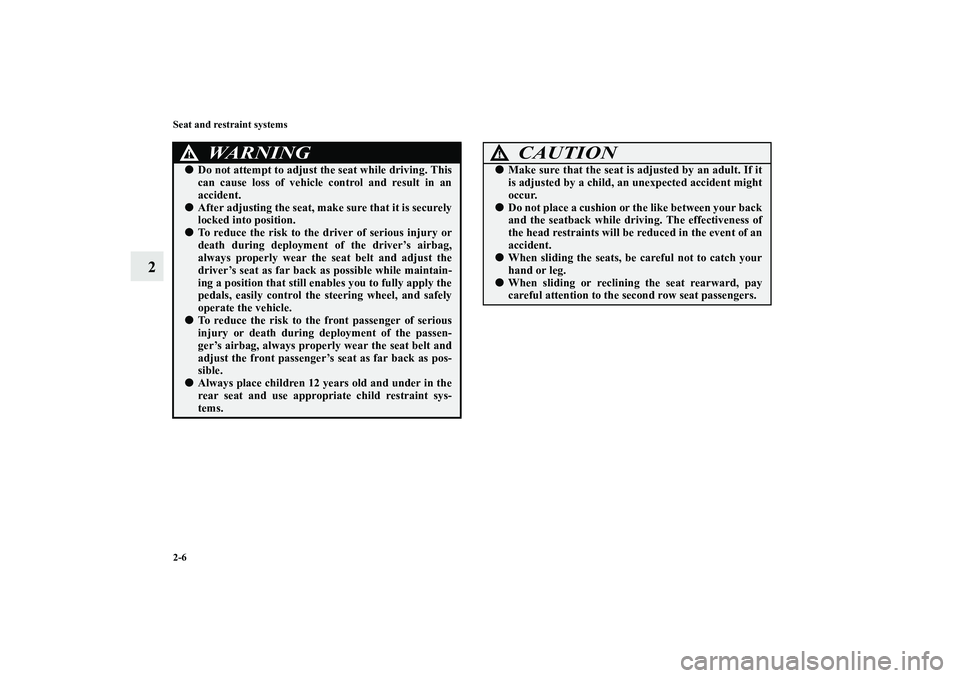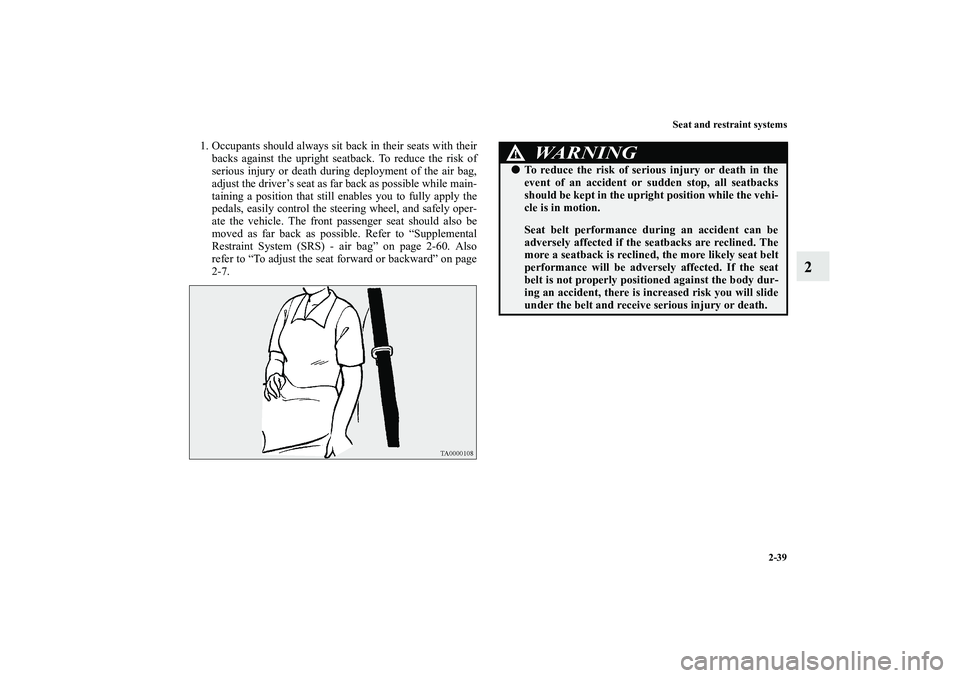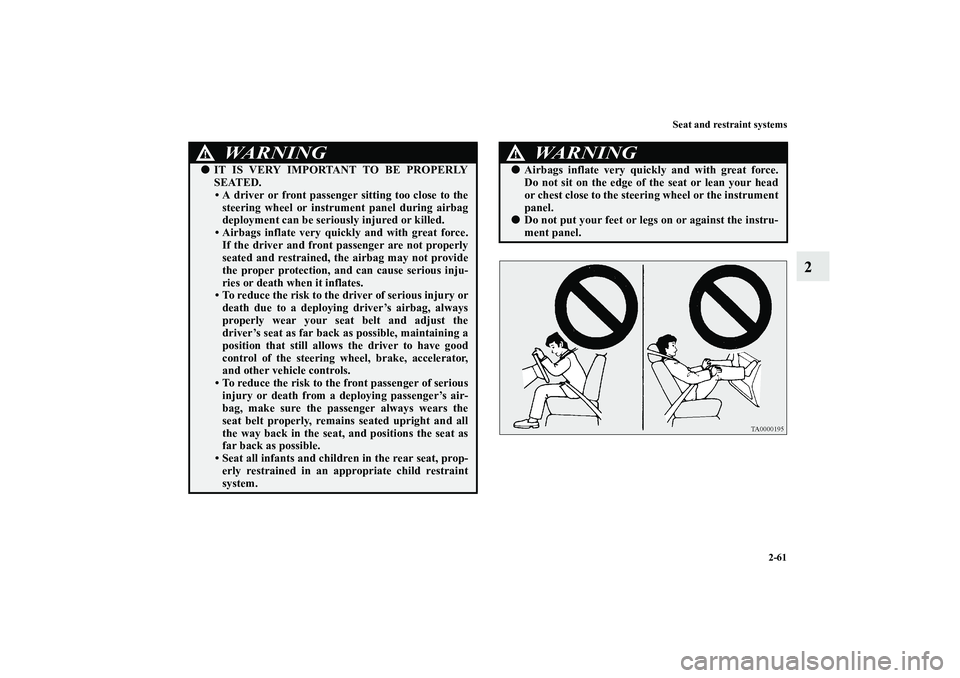Page 3 of 714
Overview
Instruments and controls
N00100201260
Cruise control switch
(if so equipped)
P. 3 - 1 4 0 Active stability control (ASC)
(if so equipped) P.3-137, 3-169
Ignition switch P.3-25, 3-87Steering wheel tilt lock lever
P. 3 - 8 2 Wiper and washer switch P.3-225
Rear window wiper and washer
switch P.3-232 Instrument cluster P.3-157
Supplemental restraint system (SRS) - airbag (for driver’s seat) P.2-60, 2-70
Horn switch P.3-235Combination headlights and dimmer switch P.3-214
Turn signal lever P.3-222
Front fog light switch
(if so equipped) P.3-224
Sportronic steering wheel paddle
shifter (if so equipped)
P.3-99, 3-109
Steering wheel audio remote control
switches (if so equipped) P.5-120
Bluetooth
® 2.0 interface (if so equipped)
P. 3 - 2 3 6Headlight leveling switch
(if so equipped) P.3-221
BK0115300US.book 1 ページ 2009年11月30日 月曜日 午後2時1分
Page 12 of 714

Quick index
3
If this problem occurs...
N00200900753
Problem
Do this
Ref. Page
Cannot turn the key.
(When using a key to start the
engine)When using a key to start the engine
Will not turn from “LOCK” to “ACC”.
Turn the key while turning the steering wheel in either direction.P. 3-87
Will not turn from “ACC” to “LOCK”.
Check the position of the selector lever.
The key cannot be removed unless the selector lever is set to the “P” (PARK) position.P. 3-88
(When using the F.A.S.T.-key
to start the engine)
When using the F.A.S.T-key to start the engine
Will not turn from “LOCK (PUSH OFF)” to “ACC”.
Push the ignition switch again, turn the steering wheel in both directions and then turn the
ignition switch.
Will not turn from “ACC” to “LOCK”.
Check whether the selector lever is set to the “P” (PARK) position.P. 3-26
P. 3-27
The F.A.S.T.-key does not
operate.
(for vehicles equipped with the
F. A . S . T. - k e y )Use the emergency key to lock and unlock the doors and the tailgate, and start the engine. P.3-35
Cannot shift the selector lever
from the “P” (PARK) position.Shift the selector lever while pressing the brake pedal.
Check that the ignition switch is in the “ON” position.P. 3-94
BK0115300US.book 3 ページ 2009年7月16日 木曜日 午前9時13分
Page 30 of 714

Seat and restraint systems
2-5
2 Seats and restraint systems
N00401600153
Your vehicle has seat belts and other features that help protect
you and your passengers in an accident.
Seat belts are the most important safety device. When worn
properly, seat belts can reduce the chance of serious injury or
death in various types of crashes. For added protection during a
severe frontal collision, your vehicle has a Supplemental
Restraint System (SRS) with airbags for the driver and passen-
gers. The seats, head restraints, and door locks also are safety
equipment, which must be used correctly.
Always check the following before you drive:�
That everyone in your vehicle is properly wearing their
seat belt.
�
That infants and small children are properly secured in
appropriate child restraint systems in the rear seat.
�
That all doors are fully closed and locked.
�
That seatbacks are upright, with head restraints properly
adjusted.
Safety equipment cannot prevent injury or death in all motor
vehicle accidents. You can help reduce the risk of injury or
death, however, by following the instructions in this manual.
Front seats
N00401800331
Position the driver’s seat as far back as possible while main-
taining a position that still enables you to fully apply the ped-
als, easily control the steering wheel and safely operate the
vehicle.
Power seat adjustment Manual seat adjustment
BK0115300US.book 5 ページ 2009年7月16日 木曜日 午前9時13分
Page 31 of 714

2-6 Seat and restraint systems
2
WA R N I N G
!�
Do not attempt to adjust the seat while driving. This
can cause loss of vehicle control and result in an
accident.
�
After adjusting the seat, make sure that it is securely
locked into position.
�
To reduce the risk to the driver of serious injury or
death during deployment of the driver’s airbag,
always properly wear the seat belt and adjust the
driver’s seat as far back as possible while maintain-
ing a position that still enables you to fully apply the
pedals, easily control the steering wheel, and safely
operate the vehicle.
�
To reduce the risk to the front passenger of serious
injury or death during deployment of the passen-
ger’s airbag, always properly wear the seat belt and
adjust the front passenger’s seat as far back as pos-
sible.
�
Always place children 12 years old and under in the
rear seat and use appropriate child restraint sys-
tems.
CAUTION
!�
Make sure that the seat is adjusted by an adult. If it
is adjusted by a child, an unexpected accident might
occur.
�
Do not place a cushion or the like between your back
and the seatback while driving. The effectiveness of
the head restraints will be reduced in the event of an
accident.
�
When sliding the seats, be careful not to catch your
hand or leg.
�
When sliding or reclining the seat rearward, pay
careful attention to the second row seat passengers.
BK0115300US.book 6 ページ 2009年7月16日 木曜日 午前9時13分
Page 62 of 714

Seat and restraint systems
2-37
2
5. The flat seat configuration is now complete.
To return the seats to the normal position, reverse the
above procedure.
Seat belts
N00406000426
Seat belts are installed in your vehicle to help reduce the risk of
injury to the driver and passenger in the event of an accident.
Always use the provided seat belts.
Carefully review the following information for proper seat belt
usage.
WA R N I N G
!�
To help reduce the risk of injury or death in an acci-
dent, seat belts and child restraints must always be
used. Refer to “Child restraints” on page 2-49 for
additional information.
�
Never use one seat belt for more than one person.
�
Never carry more people in your vehicle than there
are seat belts.
�
Always adjust the seat belt for a snug fit.
�
Always place the shoulder belt over your shoulder
and across your chest. Never put it behind you or
under your arm.
�
Always wear the lap belt as low as possible across
your hips, not around your waist.
�
Never modify or alter the seat belts in your vehicle.
�
To reduce the risk to the driver of serious injury or
death during deployment of the driver’s airbag,
always properly wear the seat belt and adjust the
driver’s seat as far back as possible while maintain-
ing a position that still enables you to fully apply the
pedals, easily control the steering wheel, and safely
operate the vehicle.
BK0115300US.book 37 ページ 2009年7月16日 木曜日 午前9時13分
Page 64 of 714

Seat and restraint systems
2-39
2
1. Occupants should always sit back in their seats with their
backs against the upright seatback. To reduce the risk of
serious injury or death during deployment of the air bag,
adjust the driver’s seat as far back as possible while main-
taining a position that still enables you to fully apply the
pedals, easily control the steering wheel, and safely oper-
ate the vehicle. The front passenger seat should also be
moved as far back as possible. Refer to “Supplemental
Restraint System (SRS) - air bag” on page 2-60. Also
refer to “To adjust the seat forward or backward” on page
2-7.
WA R N I N G
!�
To reduce the risk of serious injury or death in the
event of an accident or sudden stop, all seatbacks
should be kept in the upright position while the vehi-
cle is in motion.
Seat belt performance during an accident can be
adversely affected if the seatbacks are reclined. The
more a seatback is reclined, the more likely seat belt
performance will be adversely affected. If the seat
belt is not properly positioned against the body dur-
ing an accident, there is increased risk you will slide
under the belt and receive serious injury or death.
BK0115300US.book 39 ページ 2009年7月16日 木曜日 午前9時13分
Page 86 of 714

Seat and restraint systems
2-61
2
WA R N I N G
!�
IT IS VERY IMPORTANT TO BE PROPERLY
SEATED. A driver or front passenger sitting too close to the
steering wheel or instrument panel during airbag
deployment can be seriously injured or killed.
Airbags inflate very quickly and with great force.
If the driver and front passenger are not properly
seated and restrained, the airbag may not provide
the proper protection, and can cause serious inju-
ries or death when it inflates.
To reduce the risk to the driver of serious injury or
death due to a deploying driver’s airbag, always
properly wear your seat belt and adjust the
driver’s seat as far back as possible, maintaining a
position that still allows the driver to have good
control of the steering wheel, brake, accelerator,
and other vehicle controls.
To reduce the risk to the front passenger of serious
injury or death from a deploying passenger’s air-
bag, make sure the passenger always wears the
seat belt properly, remains seated upright and all
the way back in the seat, and positions the seat as
far back as possible.
Seat all infants and children in the rear seat, prop-
erly restrained in an appropriate child restraint
system.
WA R N I N G
!�
Airbags inflate very quickly and with great force.
Do not sit on the edge of the seat or lean your head
or chest close to the steering wheel or the instrument
panel.
�
Do not put your feet or legs on or against the instru-
ment panel.
BK0115300US.book 61 ページ 2009年7月16日 木曜日 午前9時13分
Page 95 of 714
2-70 Seat and restraint systems
2
Driver’s and passenger’s front airbag system
N00407900288
The driver’s airbag is located under the padded cover in the
middle of the steering wheel. The front passenger’s airbag is
contained in the instrument panel above the glove compart-
ment. The driver’s airbag and the front passenger’s airbag are
designed to deploy at the same time. However, the front pas-
senger’s airbag does not deploy when the front passenger seat
is not occupied or when the weight sensor in the front passen-
ger seat senses a weight on the seat of less than approximately
about 66 pounds (30 kg).
Driver
Front passenger
BK0115300US.book 70 ページ 2009年7月16日 木曜日 午前9時13分